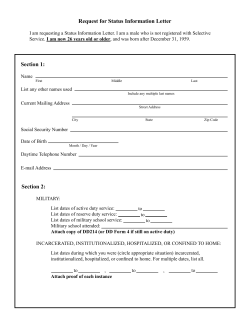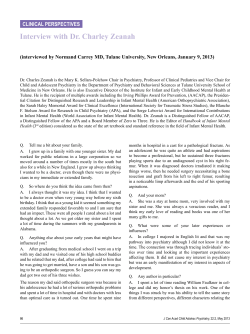
Presentation Materials Selective Mutism and Reluctance to Speak: Treatment Considerations for Complex
Presentation Materials Selective Mutism and Reluctance to Speak: Treatment Considerations for Complex Clinical Profiles Presented Tuesday, February 12, 2013 Collette Fischer, Tiffany Born, & Julia McGivern University of Wisconsin- Madison National Association of School Psychologists 2013 Annual Convention February 12-15, 2013 Seattle, WA Guidelines for Helping Children Speak Start with very small goals, such as playing a fun game that has some speaking requirements, such as Uno or Go Fish. Give children predictable responses so they know what they are expected to say. For example, be sure children know what to call the cards in Go Fish or the rules of Uno. Begin with individuals (often parents) and settings (often home and sometimes school) in which children will already speak. Gradually add new individuals or transition to new settings. Children usually feel more comfortable talking in one-on-one situations or in small groups. Gradually move to larger groups. Gradually increase expectations and provide opportunities for speaking; taking small steps is essential. Do not force children to speak or punish them for not speaking because this can sometimes make them more anxious. Older children need to feel some control in setting expectations so they are not asked to do things they cannot do. Whenever possible, involving them in intervention decisions is ideal. When children do speak, treat them as you treat other children when they speak. For example, say "thank you for your answer" rather than "great job speaking." Help others to also react calmly when children speak. If using rewards, o/ive children smaller and more frequent rewards rather than one big reward for speaking. Help older children monitor their progress through self-monitoring sheets, etc. Star charts, log books, and other visual aids can be helpful for charting progress toward the speaking goal. Reinforce children for any steps taken toward verbal communication. Reduce reinforcement (e.g., special attention and privileges) for nonverbal communication. When planning for school activities, identify speaking opportunities that you can prepare for with the student (e.g., tell the child what question you will ask and ensure the child knows the answer). 1 Working with Students with Selective Mutism in the Classroom What is Selective Mutism? Selective Mutism (SM) is a childhood anxiety disorder in which children have difficulty speaking in select situations, such as school, despite their ability to speak normally in situations where they are comfortable, such as at home. The symptoms of Selective Mutism are not caused by a communication or pervasive developmental disorder (DSM-IV-TR). How can teachers work best with children with SM? s Create a comfortable, safe, and nurturing environment for children with selective mutism. s Have children with selective mutism practice speaking in the classroom when few other children are around to help them realize that they CAN speak in school. s Give, children with selective mutism predictable responses so they know what they are expected to say. s Gradually increase expectations and provide opportunities for speaking. Children with selective mutism need to move in small steps. s Children with selective mutism usually feel more comfortable practicing talking in 1:1 situations or in small groups. s Children need to feel some control in setting expectations so they are not asked to do things they cannot do. Involving them in intervention decisions is important, if possible. s When children with selective mutism do talk, treat them as you treat all other children when they talk. It is important not to make a spectacle (e.g., say, "thank you for your answer," rather than, "great job talking"). •s Give children smaller, more frequent rewards, rather than one big reward for talking. s Reinforce children with selective mutism for steps toward verbal communication. s Reduce reinforcement (e.g., special attention & privileges) for nonverbal communication. 2 Date: ___________________________ How hard would this be for you? Directions: Read the statements below. In the first column, circle HOW MUCH you would like to work on what is written in the statement. In the second column, circle HOW HARD this would be for you. For both columns, use a scale from 1 to 4 where 1 is the lowest (A LITTLE or NOT HARD) and 4 is the highest (VERY MUCH or VERY HARD) How much would you like to work on this? Names: _________________ __________________ __________________ Names: _________________ 1 1 1 1 1 2 2 2 2 2 2 2 3 3 3 3 3 3 3 3 4 4 4 4 4 4 4 4 4 1 1 1 1 1 1 1 1 1 1 2 2 2 2 2 2 2 2 2 2 2 3 3 3 3 3 3 3 3 3 3 3 4 4 4 4 4 4 4 4 4 4 4 VERY HARD __________________ 1 2 3 4 1 NOT HARD __________________ 1 2 3 4 VERY MUCH Ask for help at school 1 2 3 A LITTLE Ask the ‘celebrity of the week’ a question 1 Say my ideas out loud in a group 1 2 Talk to teachers at school Talk to friends at swim practice 1 Talk more with friends at school Talk to my coach at swim practice McGivern, 2013 3 How much would you like to work on this? How hard would this be for you? 1 2 2 3 3 3 4 4 4 4 1 1 1 1 2 2 2 2 3 3 3 3 4 4 4 4 VERY HARD Say good morning to __________ 1 2 3 NOT HARD Read aloud at school 1 2 VERY MUCH Whisper to ___________ 1 A LITTLE Whisper to friends in your class 4 Easy!!!3!!!Not!so!easy!!!3!!!Hard! Easy!!!3!!!Not!so!easy!!!3!!!Hard! Easy!!!3!!!Not!so!easy!!!3!!!Hard! Easy!!!3!!!Not!so!easy!!!3!!!Hard! Easy!!!3!!!Not!so!easy!!!3!!!Hard! Easy!!!3!!!Not!so!easy!!!3!!!Hard! Easy!!!3!!!Not!so!easy!!!3!!!Hard! Easy!!!3!!!Not!so!easy!!!3!!!Hard! HOME' Easy!!!3!!!Not!so!easy!!!3!!!Hard! Easy!!!3!!!Not!so!easy!!!3!!!Hard! Easy!!!3!!!Not!so!easy!!!3!!!Hard! Easy!!!3!!!Not!so!easy!!!3!!!Hard! Easy!!!3!!!Not!so!easy!!!3!!!Hard! Easy!!!3!!!Not!so!easy!!!3!!!Hard! Easy!!!3!!!Not!so!easy!!!3!!!Hard! Easy!!!3!!!Not!so!easy!!!3!!!Hard! Easy!!!3!!!Not!so!easy!!!3!!!Hard! SCHOOL' Easy!!!3!!!Not!so!easy!!!3!!!Hard! Easy!!!3!!!Not!so!easy!!!3!!!Hard! Easy!!!3!!!Not!so!easy!!!3!!!Hard! Easy!!!3!!!Not!so!easy!!!3!!!Hard! Easy!!!3!!!Not!so!easy!!!3!!!Hard! Easy!!!3!!!Not!so!easy!!!3!!!Hard! Easy!!!3!!!Not!so!easy!!!3!!!Hard! Easy!!!3!!!Not!so!easy!!!3!!!Hard! COMMUNITY' Easy!!!3!!!Not!so!easy!!!3!!!Hard! I!kind!of! want!to! talk! ! ! ! ! ! ! ! I!really! want!to! talk! ! ! ! ! ! ! ! ! ! I!don’t! want!to! talk! ! ! ! ! ! ! ! ! ! I!kind!of! want!to! talk! ! ! ! ! ! ! ! ! ! I!really! want!to! talk! ! ! ! ! ! ! ! ! ! I!don’t! want!to! talk! ! ! ! ! ! ! ! ! ! I!kind!of! want!to! talk! ! ! ! ! ! ! ! I!really! want!to! talk! SCHOOL' I!don’t! want!to! talk! ! ! ! ! ! ! ! ! ! HOME' ! ! ! ! ! ! ! ! ! ! ! ! ! ! ! Adapted'from'Sanetti'&'Luiselli,'2009' ! ! COMMUNITY' Easy!!!3!!!Not!so!easy!!!3!!!Hard! SAMPLE'ASSESSMENT:'Difficulty'Speaking'Across'Settings' ' Talking!with!my!mom!and!dad! is…! Talking!with!my!sibling!is…! Talking!with!my!grandmother! is…! Talking!with!my!teacher!is…! Talking!with!my!coach!is…! Talking!with!an!adult!I’ve!never!met! ! before!is…! Talking!with!my!friend!________! is…! Talking!with!my!friend!________! is…! Talking!with!________!is…! Dad' Mom' Sister' Teacher'' Coach' Friend'' Friends’' parent' (Name)' (Name)' ' ' ' SAMPLE'ASSESSMENT:'Motivation'to'Speak'Across'Settings' ' 5 GOAL ATTAINMENT SCALE WORKSHEET (McGivern, 2013) Student’s Name: ____ School: __________________ ____ Teacher: ___________ ______ Date: _____ ______ Goal attainment scaling (GAS) provides a method for monitoring treatment progress regarding a target behavior or problem situation. The basic elements of a GAS are a 7-point scale ranging from a 0 (skill not evident) to +6 (Exceeding or reaching goal). By using the numerical ratings for each of the 7 behavior descriptions, the respondent should be able to provide a daily report of treatment progress. (Note: P = Peer, T = Teacher) Please check the appropriate box indicating the highest benchmark achieved during each day. Monday P T Tuesday P T Wednesday P T Thursday P T Friday P T +6 +5 +4 +3 +2 +1 0 Week of __________ Target Behavior: ______________________________________________________________ 6 Benchmark: ________________________________________________________________ 5 Benchmark: _________________________________________________________________ 4 Benchmark: _________________________________________________________________ 3 Benchmark: _________________________________________________________________ 2 Benchmark: _________________________________________________________________ 1 Benchmark: _________________________________________________________________ 0 Benchmark: _________________________________________________________________ 6 Situation: Situation: Situation: Situation: ______________________________ Situation: __________________________________________________________________________________________ ______________________________ 7 8 9 10 ANXIETY ! 11 Alexis’s first day of school. What could she be thinking/ feeling? 12 13 Question Latency 1. What did you do last weekend? 1. 2. What did you learn in school today? 2. 3. Who or what is your favorite Disney character? 4. What is your favorite day of the week? 5. Would you rather go to Alaska or Hawaii? 6. What do you want to do when you grow up? 3. 4. 5. 6. 7. 7. What are some of your favorite books? 8. What are you most looking forward to this summer? 8. 9. What is your favorite thing to do in the winter? 9. 10. What is your favorite flavor of ice cream? 10. 14 During the pause, I was… 1. Working up the courage to talk 2. Thinking of something to say 3. Deciding whether or not to talk 4. Worrying that what I say may be wrong 15 Sorry Rules! 1. Pick a card. 2. Say the name of the card out loud! 3. Count the spaces out loud! 4. Say, “It’‛s your turn!” to the next player. 5. Say “SORRY!” when you knock other players off their spots. 16 TROUBLE RULES 1. Press the bubble to roll the die. 2. Say the number out loud! 3. Count the spaces out loud! 4. Say “It’s your turn!” to the next player. 17 UNO Rules! 1. When you play a card, say the name of the card out loud. 2. When you are finished with your turn, look to the next player and say, “It’‛s your turn!” 3. When you have only one card left, say “Uno!” 18 References American Psychiatric Association. (2000). Diagnostic and statistical manual of mental disorders: DSM-IV-TR. Washington, DC: Author. APA Presidential Task Force on Evidence-Based Practice (2006). Evidence-based practice in psychology. American Psychologist, 61, 271-285. Black, B., & Uhde, T. W. (1995). Psychiatric characteristics of children with selective mutism: a pilot study. Journal of the American Academy of Child & Adolescent Psychiatry; Journal of the American Academy of Child & Adolescent Psychiatry. Chorpita, B. F. (2007). Modular cognitive-behavioral therapy for childhood anxiety disorders. New York: Guilford Press. Cohan, S.L, Chavira, D.A., Shipon-Blum, E., Hitchcock, C., Roesch, S.C. & Stein, M.B. (2008). Refining the classification of children with Selective Mutism: A Latent Profile Analysis, Journal of Clinical Child & Adolescent Psychology, 37, 770-784. doi: 10.1080/15374410802359759 Cohan, S. L., Chavira, D. A., & Stein, M. B. (2006). Practitioner review: Psychosocial interventions for children with selective mutism: A critical evaluation of the literature from 1990–2005. Journal of Child Psychology and Psychiatry, 47(11), 1085-1097. Cunningham, C. E., McHolm, A., Boyle, M. H., & Patel, S. (2008). Behavioral and emotional adjustment, family functioning, academic performance, and social relationships in children with selective mutism. Journal of Child Psychology and Psychiatry, 45(8), 1363-1372. Dummit, E. S., Klein, R. G., Tancer, N. K., Asche, B., Martin, J., & Fairbanks, J. A. (1997). Systematic assessment of 50 children with selective mutism. Journal of the American Academy of Child & Adolescent Psychiatry, 36(5), 653-660. 19 Dow, S. P., Sonies, B. C., Scheib, D., Moss, S. E., & Leonard, H. L. (1999). Practical guidelines for the assessment and treatment of selective mutism. In S. A. Spasaro & C. E. Schaefer (Eds.), Refusal to speak: Treatment of selective mutism in children (pp. 19-44). Northvale, NJ: Jason Aronson. Elizur, Y., & Perednik, R. (2003). Prevalence and description of selective mutism in immigrant and native families: A controlled study. Journal of the American Academy of Child & Adolescent Psychiatry, 42(12), 1451-1459. Gidden, J. J., Ross, G. J., Sechler, L. L., & Becker, B. R. (1997). Selective mutism in elementary school: Multidisciplinary interventions. Language, Speech, and Hearing Services in Schools, 28, 127-133. Goodman, R., & Scott, S. (2012). Selective Mutism. Child and Adolescent Psychiatry, Third Edition, 141-144. Jackson, M. F., Allen, R. S., Boothe, A. B., Nava, M. L., & Coates, A. (2005). Innovative analyses and interventions in the treatment of selective mutism. Clinical Case Studies, 4(1), 81-112. Johnson, M., & Wintgens, A. (2001). The selective mutism resource manual. Bicester, UK: Speechmark Publishing Ltd. Kearney, C. A., (2010). Selective mutism and reluctance to speak: Definition and description. In C. A. Kearney, Helping children with selective mutism and their parents: A guide for school based professionals. New York: Oxford University Press. Kern, L., Starosta, K. M., Bambara, L. M., Cook, C. R., & Gresham, F. R. (2007). Functional assessment-based intervention for selective mutism. Behavioral Disorders, 32(2), 94. Kopp, S., & Gillberg, C. (1997). Selective mutism: A population-based study: A research note. Journal of Child Psychology and Psychiatry, 38, 257–262. 20 Kristensen, H. (2000). Selective mutism and comorbidity with developmental disorder/delay, anxiety disorder, and elimination disorder. Journal of the American Academy of Child & Adolescent Psychiatry, 39(2), 249-256. Kristensen, H. (2001). Multiple informants' report of emotional and behavioural problems in a nation-wide sample of selective mute children and controls. European child & adolescent psychiatry, 10(2), 135-142. Krysanski, V. L. (2003). A brief review of selective mutism literature. The Journal of Psychology: Interdisciplinary and Applied, 137(1), 29-40. Laurijssens , W. & Tonino, M. (2010, May). Down Syndrome and Selective Mutism. Paper or poster session presented at the meeting of Bridge International Conference for Intellectual Disability, Bristol, United Kingdom. Manassis, K., Fung, D., Tannock, R., Sloman, L., Fiksenbaum, L., & McInnes, A. (2003). Characterizing selective mutism: Is it more than social anxiety? Depression and Anxiety, 18, 153-161. Rapee, R. M., Wignall, A., Hudson, J.L., & Schniering, C. A. (2000). Treating anxious children and adolescents. Oakland, CA: New Harbinger. Sanetti, L.M., & Luiselli, J.K. (2009). Evidence-based practices for selective mutism: Implementation by a school team. School Psychology Forum: Research in Practice, 3, 27-42. Snyder, D. M., Miller, K., & Stein, M. T. (2008). It looks like autism: caution in diagnosis. Journal of Developmental & Behavioral Pediatrics, 29(1), 47-50. Standart, S., & Couteur, A. L. (2003). The quiet child: A literature review of selective mutism. Child and Adolescent Mental Health, 8(4), 154-160. 21 Steinhausen, H., Wachter, M., Laimbock, K, & Winkler Metzke, C. (2006). A long-term outcome study of selective mutism in childhood. Journal of Child Psychology and Psychiatry, 47, 751-756. Stone, B. P., Kratochwill, T. R., Sladezcek, I., & Serlin, R. C. (2002). Treatment of selective mutism: A best-evidence synthesis. School Psychology Quarterly, 17(2), 168-190. Tabors, P. O. (1997). One child, two languages: A guide for preschool educators of children learning English as a second language. Baltimore, MD: Brookes. Toppelberg, C. (2005). Differential Diagnosis of Selective Mutism in Bilingual Children. Journal of the American Academy of Child and Adolescent Psychiatry, 44, 592-595. Vecchio, J. L., & Kearney, C. A. (2005). Selective mutism in children: Comparison to youths with and without anxiety disorders. Journal of Psychopathology and Behavioral Assessment, 27(1), 31-37. Yeganeh, R., Beidel, D. C., Turner, S. M., Pina, A. A., & Silverman, W. K. (2003). Clinical distinctions between selective mutism and social phobia: an investigation of childhood psychopathology. Journal of the American Academy of Child and Adolescent Psychiatry, 42(9), 1069-1075. 22
© Copyright 2025














